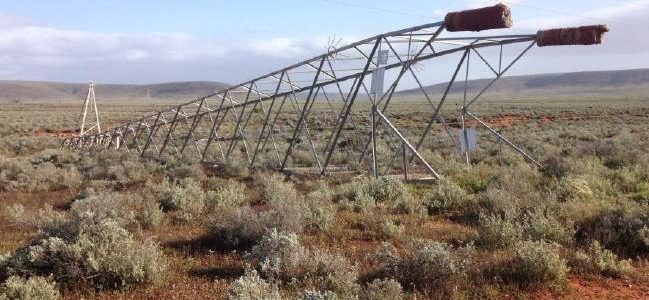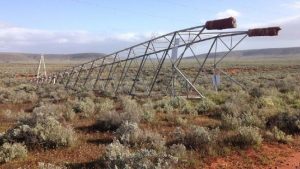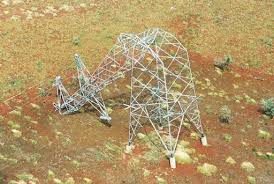
Renewables

South Australian pylons after120kph winds

Queensland pylons after 290 kph
“South Australia hasn’t seen a storm like last week’s in living memory,” Mr Weatherill said. “Those images of transmission lines bent over showed just how powerful the wind was.”No, those images show just how flimsy the infrastructure was. I put more concrete around the base of my fence posts than the SA guys did around their pylons. Yes, the storm produced the blackout but there’s more to it than that. The wind turbines closed down before the pylons were knocked out and the sudden drop in power from wind caused a huge instant demand from the Victoria connector. It closed down to protect the Victorian energy system. If SA had coal or gas generators on line it wouldn’t have blacked out. From Graham Llloyd in The Australian quoting a report from the AEMO
A dramatic, sudden loss of wind power generation was the root cause of South Australia’s state wide blackout last week. And the bulk of damage to high voltage transmission lines that was caused by high winds and paraded as evidence to defend renewables most likely took place after the power had been lost. These are the major facts contained in the Australian Energy Market Operator’s (AEMO) preliminary report.Graham continues;
But AEMO said data currently available indicates that the damage to the Davenport to Brinkworth 275 kV line on which 14 towers were damaged “occurred following the SA Black System”. The big event was a 123 MW reduction in output from North Brown Hill Wind Farm, Bluff Wind Farm, Hallett Wind Farm and Hallett Hill Wind Farm at 16.18.09. Seconds later there was an 86 MW reduction in output from Hornsdale wind farm and a 106 MW reduction in output from Snowtown Two wind farm.Renewables are fine so long as there is a base load source to maintain the grid. Green left wing state governments are outbidding each other in taking us along the road to renewables without listening to engineering advice. They will cost us dearly. Link here to The AEMO Report. Greenies should read it and ponder.
“Link here to The AEMO Report. Greenies should read it and ponder.”
I took your advice, and did that, Kev.
My reading revealed a couple of interesting facts.
The first is that your report of the sequence is wrong. You write “The wind turbines closed down before the pylons were knocked out”
Now I’ve never been much good at using 24-hour time – it was always a pain in the arse when I was a Nasho, but I’m pretty sure that 16:16 is two minutes before 16:18 – correct me if I’m wrong.
From the report – “The weather resulted in multiple transmission system faults. In the short time between 16:16 and 16:18, system faults included the loss of three major 275 kV transmission lines north of Adelaide.
Generation initially rode through the faults, but at 16:18, following an extensive number of faults in a short period, 315 MW of wind generation disconnected (one group at 16:18:09, a second group at 16:18:15), also affecting the region north of Adelaide.”
So the wind generators disconnected after the transmission towers went down, not before. That contradicts what you wrote above. Sequence is important. I discovered this when I had a UD with my SLR in SVN, when I cocked the rifle before removing the mag, and then pulled the trigger to show the weapon was cleared. It wasn’t.
So we’ve established the sequence (towers down first – wind generators off line a few minutes later). What the AEMO report doesn’t say is why the generators tripped. I’ve heard reports (interviews with engineers) that it was down to bad programming – we’ll eventually know when the final report comes out.
Now let’s look at the towers – which comparative pics you helpfully posted. The SA towers were pulled out by the roots. The Queensland ones deformed. Accepting your estimation of wind velocity, a reasonable conclusion is that the Qld towers were of better quality than the SA examples.
One major difference between the two states is that the SA infrastructure was privatized in 1999. Queensland’s is still in public hands. Remember how the LNP lost an election around that issue?
Remember also that poor maintenance on a privatized Victorian network was the triggering event for the 2009 bush fires in that state. Remember the class action and the multi million payout? – http://www.abc.net.au/news/2014-07-15/black-saturday-bushfire-survivors-secure-record-payout/5597062
It’s also a reasonable conclusion that the parlous state of the SA infrastructure is a consequence over time of its privatization in 1999. The 23% increase in tariffs is also an outcome of that same privatization. There’s much more money in tariffs than maintenance.
Perhaps electricity consumers in SA should go to class action.
The most revealing extract from the AEMO report is this – “The event resulted in the SA regional electricity market being suspended.” Now that is revealing.
To AEMO, it’s a “market”. I suspect the electricity consumers in SA have a different idea. They probably regard it as a service.
A little more light shed on the subject, Kev.
http://www.xyz.net.au/well-rooned-said-hanrahan-part-1/
This is interesting – http://www.theregister.co.uk/2016/10/19/proprietary_software_not_intermittency_blacked_out_south_australia/